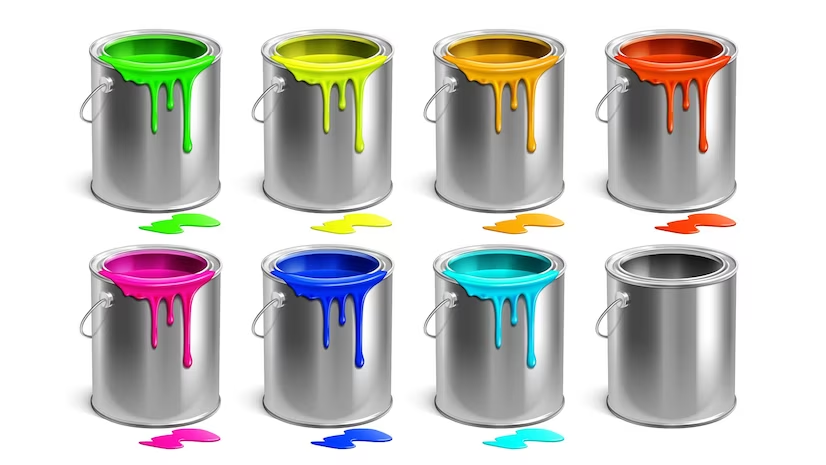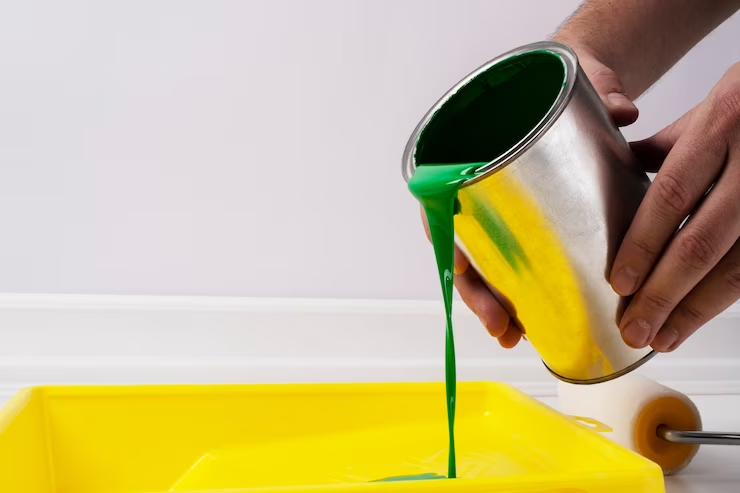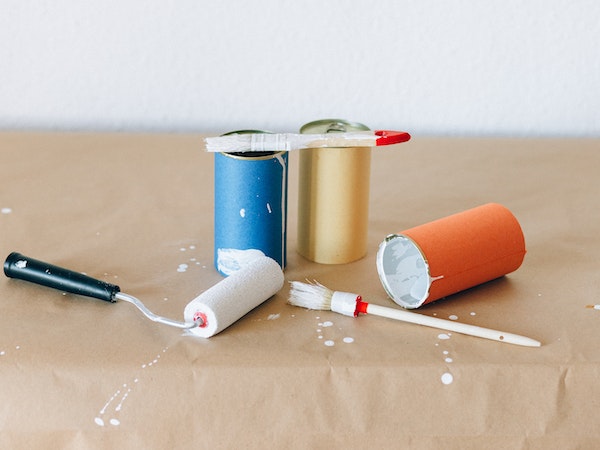If you’re a paint lover, ‘latex’ is a term you’ll commonly see on product labels and encounter in conversations with DIY enthusiasts.
Latex paint has become popular due to its versatility, ease of use, and environmental friendliness. However, a question that most people still ask is, ‘Is latex paint water based?’
In this blog post, we’ll discuss the nature of latex paint by exploring its formulation, characteristics, and whether or not it’s water-based. We’ll also compare its characteristics to other paint types, like oil-based paint, to help you make the best decision for your next painting project.
Is Latex Paint Water Based?
Yes, latex paint is water-based. The term ‘latex’ in latex paint refers to synthetic polymers (acrylic or vinyl) dispersed in water. Unlike oil paint, which uses solvents for dispersion, latex paint relies on water as its primary vehicle, making it easier to clean with soap and water.
Is acrylic latex paint water-based?
Yes. Acrylic latex paint is water-based.
It’s a type of latex paint that uses acrylic polymers as the binder. Acrylic latex paint is made by suspending acrylic particles in water, which act as the vehicle for the paint. It offers excellent adhesion and forms a durable film.
Like other water-based paints, acrylic latex paint dries quickly and is easy to clean using soap and water.
Is latex enamel paint water-based?
No, latex enamel paint is not water-based. While it contains the term “latex,” it differs from water-based paints.
Latex enamel paint is a modified version of oil-based enamel paint containing latex or acrylic resins. These resins provide enhanced durability and a glossy finish similar to oil-based enamel paints but with easier clean-up using soap and water.
However, latex enamel paint still contains solvents like mineral spirits and paint thinners like linseed oil. Therefore, despite having latex or acrylic resins, latex enamel paint is classified as oil-based rather than water-based.
Is latex paint oil or water-based?
Latex paint is water-based.
It’s called ‘latex’ since it’s made of synthetic polymers like acrylic or vinyl dispersed in water as the primary solvent.
Oil-based paints, on the other hand, use solvents like mineral spirits and turpentine to dissolve the polymers. Unlike oil-based paint, which requires solvents to clean, water-based paints are easy to clean using soap and water only.
Is flat latex paint water-based?
Yes, flat latex paint is water-based.
The term ‘flat’ refers to the finish or sheen of the paint, indicating a matte or non-reflective appearance. Like other types of latex paint, flat latex paint is made using synthetic polymers like acrylic or vinyl, dispersed in water as the primary solvent.
It dries relatively quickly and is commonly used for interior walls and ceilings.
Types of Water-Based Paints

When it comes to water-based paints, there are generally two common types: Acrylic and latex water-based paint.
1. Acrylic paint
This is a popular water-based paint made of pigment particles suspended in an acrylic resin emulsion. It can be used on various surfaces, including canvas, wood, and paper.
Acrylic paint is known for its excellent color retention, durability, and resistance to cracking or yellowing over time. It’s commonly used in art and craft applications.
2. Latex Paint
Latex paint is commonly referred to as water-based paint or acrylic latex paint. It’s a water-based paint that uses synthetic polymers (acrylic or vinyl) as the binders dispersed in water.
As the water evaporates during the drying process, the polymers form a film that results in a durable and flexible coating.
However, the acrylic content of latex paint is relatively lower than that of acrylic paint.
Like acrylic paints, latex paint is easy to clean using soap and water, dries quickly, and has a low odor. It is commonly used for interior and exterior applications like painting walls, ceilings, and trim.
Latex paint is typically used for architectural and decorative purposes. Check out how acrylic and latex compare and which one you should choose based on your project needs.
Why is latex paint considered water-based paint?
Are you still wondering why latex paints are water-based rather than oil-based?
Latex paints are considered water-based due to their composition and the manufacturing process involved.
Here are the main reasons:
1. Primary solvent
Latex paint uses water as its primary solvent or vehicle. This means synthetic polymers like acrylic or vinyl are dispersed in water during manufacturing to create the paint formulation.
As the paint dries, the water evaporates, leaving behind the film formed by the polymers.
2. No oil and harsh solvents
Unlike oil-based paint, latex paint has no oil or harsh solvents like mineral spirits.
It relies on water for dilution, making it easy to clean and environmentally friendly.
3. Low VOC content
Latex paint is known for its low volatile organic compound (VOC) content. VOCs are chemicals that release harmful fumes into the air during paint application and drying.
Since latex paint use water as the primary solvent, they have low VOC emission and are, therefore, safer to work with.
4. Key ingredients
Additionally, latex water-based paint consists of other key components that work together to create a durable and versatile coating.
Some of them include:
Pigments: These are finely ground particles that give the paint its color.
Additives: Latex paints also have various additives that enhance their performance and applicability. Some of the additives include:
- Thickeners, which enhance viscosity to prevent sagging and dripping.
- Surfactants, which improve the flow and ensure an even paint finish.
- Biocides, which prevent the growth of mold, mildew, and bacteria in the paint film, enhancing its durability and longevity.
- Defoamers, which minimizes the formation of foam and bubbles during manufacturing and application.
- Wetting agents, improve adhesion and help the paint to spread evenly across the surface.
What is the difference between oil-based paints and water-based paint?
Oil-based paints and water-based paints, like latex paint, have some key differences in composition and functioning.
Here is a brief comparison of the two:
1. Composition
While oil-based paints use organic solvents like mineral spirits and turpentine as the primary vehicle, water-based paints use water as the primary solvent.
Water-based paints use synthetic polymers like acrylic and vinyl as binders. On the other hand, the binders in oil-based paints are alkyd resins derived from oil or vegetable-based sources.
2. Application and drying time
Water-based paints dry relatively quickly, typically within a few hours. They cure faster and can be recoated or handled sooner. This makes them suitable for quick projects and wide-range surfaces like walls and ceilings.
Oil-based paints take longer to dry— they often need hours to days to dry and cure fully. However, they allow for better leveling and brushwork.
They are best for surfaces that require a smoother finish, like trim, cabinets, or furniture.
3. Clean-up
Since they use water as the primary vehicle, water-based paints are easy to clean using soap and water.
Also, to clean the paint brushes and any tools used during the project, you can simply rinse them with water, and you’re good to go.
Oil-based paints, on the other hand, require solvents like mineral spirits or paint thinners to clean up the paint, brushes, and other paint-stained tools.
Best Uses for Water-Based Latex Paints
Are you wondering whether to use water-based latex paint for your home improvement project or a different type of paint?
One interesting thing about water-based paints is that they are versatile and, therefore, suitable for various applications.
Here are some situations when water-based latex paint would be a great choice:
- When painting interior walls and ceilings.
- When working on DIY art and craft projects.
- When painting furniture and wooden surfaces like kitchen cabinets, doors, and trims.
- When working on exterior walls and other outdoor surfaces.
- For painting aluminum siding.
- For painting concrete, drywall, and plaster.
- For decorating children’s room and play area
Water-based Latex Versus Acrylic Paint: What’s the Difference?

Though acrylic and latex paint are both water-based, there are some significant differences between the two.
Here are the notable differences between latex and acrylic paint you need to know before making a choice:
Appearance
Acrylic paint typically has a more vibrant and intense color. It also offers a wide range of finishes, including matte, satin, and glossy.
On the other hand, latex paint provides a more subtle color palette. It’s commonly available in flat/matte, satin, semi-gloss, and high-gloss finishes.
Cost
Acrylic paint is generally more expensive than latex paint since it has a higher concentration of acrylic polymers.
Latex paint is typically more affordable and widely accessible for home improvement and general painting projects.
Durability
Acrylic paint is known for its excellent durability, adhesion, and resistance to cracking or peeling. It retains its color well and can withstand outdoor conditions with proper sealing.
While latex paint is also durable, it may not be as resilient as acrylic paint in harsh weather conditions or high-traffic areas.
Ease of Use
Acrylic paint is easy to use and can be thinned with water or mediums for various techniques. It dries quickly, allowing for layering and quick project completion.
Latex paint is also user-friendly and easy to apply. However, it has a longer drying time compared to acrylic paint. This can be advantageous for achieving a smooth finish and brushwork.
Eco-friendliness
Some acrylic paints, especially artist-grade, may contain higher levels of volatile organic compounds.
Latex paint is generally more eco-friendly as it has lower VOC levels, reducing harmful emissions and environmental impact.
Pros and cons of latex water-based paint
Before you decide to use latex water-based paint for any painting project, it’s important to understand its pros and cons.
Let’s look at some of the notable pros and cons of latex paint so you can know the benefits and take precautions where necessary.
Pros of water-based paints
- Affordable
- Easy to clean up with soap and water.
- Quick drying time.
- Highly versatile.
- Low odor.
- Environmentally friendly (low VOC levels)
- Requires a few coats to covers a surface.
- Doesn’t yellow or chip over time.
Cons of water-based paints
- Doesn’t adhere to glossy surfaces like metal.
- Is not rust-resistant.
- May fail to hide brush strokes.
- Can cause the wood grain to swell.
Tips for Using water-based latex paint effectively
Want to achieve the perfect result with your painting project? Here are some tips to help you achieve effective results with water-based latex paint.
- Ensure proper ventilation by opening windows or using fans to improve airflow.
- Always prepare the surface by cleaning windows or using fans to improve airflow.
- Stir the paint thoroughly to ensure a consistent texture before use.
- Before applying, test the paint on a small area to check color and coverage.
- Use latex-based paint brushes or rollers.
- Apply a primer to help the paint adhere well and achieve a smooth surface.
- Apply thin coats and let them dry before adding another.
- Buy high quality latex paint to achieve the best results.
FAQs – Is Latex Paint Water Based
Is all latex paint water-based?
Yes. All latex paint is water-based since they use water as the primary solvent. This makes them easier to clean up and less toxic than oil-based paint.
Do you mix latex paint with water?
No. You don’t need to mix latex paint with water since it’s already formulated with water. When you buy latex paint, it’s ready for use as is. However, if it thickens over time, you can add a small amount of water to restore consistency.
Are latex and water-based paint the same?
Yes. Latex paint and water-based paint are the same. The two terms are often used interchangeably to refer to the same type of paint, which uses latex as the binder and water as the solvent.
What is acrylic latex paint?
Acrylic latex paint is a type of paint that uses acrylic resins as binders. It offers excellent adhesion, durability, and color retention. Acrylic latex paint is commonly used to paint both interior and exterior surfaces.
Is latex paint acrylic based?
Yes, latex paint is acrylic based since it contains a combination of acrylic resins and latex binders. This combination results in a paint that’s highly durable, easy to clean, and resistant to cracking and peeling.
Conclusion
Latex paint is a water-based paint that’s easy to use and preferred due to its numerous advantages over oil-based paint.
If you need environmentally friendly paint that dries fast and has a low odor, then latex paint would be your best option.
Whether you’re a professional painter working for a client or working on your own passion project, latex paint will never disappoint. It provides excellent coverage, durability and adheres well to various surfaces. Therefore, it’s a reliable and user-friendly option for interior and exterior painting projects.

